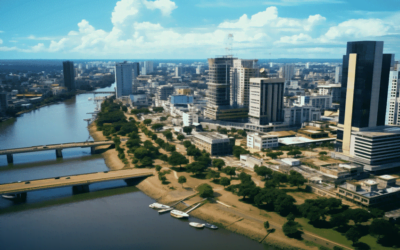Hey there, fellow drone enthusiasts! If you’re anything like me, you’re probably eager to explore the stunning landscapes and vibrant culture of Suriname from the sky.
But before you launch your drone into the tropical skies of this South American gem, you’re likely searching for answers to your burning questions about Suriname’s drone laws. Well, guess what? I’ve got you covered!
In my quest to unearth the ins and outs of Suriname’s drone regulations, I dove headfirst into the intricacies of their laws and regulations. Trust me, it’s a complex web of rules that can be somewhat perplexing at first glance.
But I’ve done the legwork to decipher these laws, so you won’t have to. I’ve sifted through official documents, talked to local experts, and conducted thorough research to ensure that you’re armed with the most up-to-date and accurate information.
So, if you’re itching to take your drone on a thrilling adventure in Suriname or simply want to understand the do’s and don’ts of drone flying in this beautiful country, you’re in the right place.
In the pages of this article, you’ll find a comprehensive guide to Suriname’s drone laws. From registration requirements to no-fly zones, we’ve got it all covered. Keep reading, and I’ll make sure you’re well-prepared to navigate the Surinamese skies like a pro!
Overview of Drone Regulations in Suriname

Before we dive into the nitty-gritty of Suriname’s drone laws, let’s set the stage with a little background. Understanding the context is crucial to navigating the regulatory landscape effectively. So, here’s a quick primer on how Suriname approaches the world of drones.
Background Information on Suriname’s Approach to Drone Regulations
Suriname, often referred to as the “Land of Many Waters,” is a stunning mix of lush rainforests, meandering rivers, and a rich cultural tapestry.
It’s no surprise that drones have become a popular tool for capturing natural beauty and unique landscapes. But with great power comes great responsibility, right?
Suriname, like many countries, recognized the need to establish regulations for drone use. They’re keen on balancing the growing interest in drones with safety and privacy concerns.
The government of Suriname has taken a proactive approach to address these issues. The result? A set of rules and regulations to ensure that drones can peacefully coexist with the country’s beautiful environment and its people.
The Responsible Government Agency (Civil Aviation Authority of Suriname)
Now, who’s in charge of keeping the drone enthusiasts in check? Meet the Civil Aviation Authority of Suriname.
This agency is the go-to authority when it comes to all things aviation-related in Suriname. They’ve got their eyes on the skies, making sure that drone operations adhere to the rules.
The Civil Aviation Authority of Suriname oversees drone registration, licensing, and enforcement of the regulations.
They are the ones who’ll answer your questions, issue permits, and ensure compliance. Their role is crucial in maintaining order in the friendly skies of Suriname.
The Purpose of Drone Regulations in Ensuring Safety and Privacy
Safety and privacy are two words that resonate across the globe when it comes to drones. In Suriname, it’s no different. The drone regulations in this country are designed with two primary objectives in mind: safety and privacy.
Safety is paramount. These regulations aim to prevent accidents, protect property, and, most importantly, ensure that the people of Suriname can go about their daily lives without fearing the skyward hum of drones.
Adhering to altitude limits, respecting no-fly zones, and flying within specified hours are some of the key ways these laws ensure safety.
Privacy is equally critical. Drones equipped with cameras can easily encroach on people’s privacy, and nobody wants that.
The regulations set boundaries on how and where you can capture images and videos, with a strong emphasis on respecting the privacy rights of individuals. The goal is to balance the beauty of aerial photography with the sanctity of personal lives.
Now that we’ve got the lay of the land, let’s dive deeper into these regulations to ensure you’re fully prepared for your drone adventures in Suriname.
Also Read: Drone Laws in South Sudan 2024
Key Drone Laws and Regulations

Now, let’s get to the heart of the matter—the specific drone laws and regulations in Suriname. Whether you’re a seasoned drone pilot or a newbie eager to explore the skies, these are the rules that will define your drone adventures in this picturesque country.
Registration and Licensing Requirements
Operational Rules and Restrictions
Altitude Limits for Drone Flights: Flying high in the sky can be exhilarating, but Suriname’s drone laws set specific limits. In most cases, drones are not allowed to exceed 400 feet (about 120 meters) above ground level. This limit helps avoid conflicts with manned aircraft, ensuring a safe coexistence in the airspace. Always keep an eye on your altitude to stay within the legal boundaries.
No-Fly Zones and Restricted Areas: Just like anywhere else, Suriname designates certain areas as no-fly zones or restricted areas. These locations are often near airports, government buildings, and other sensitive sites. Respect these restrictions to maintain safety and adhere to the law. The last thing you want is a drone mishap near a busy airport.
Flying Near Airports and Other Sensitive Locations: It’s common sense, but it’s worth emphasizing—avoid flying your drone near airports or any other sensitive locations. Flying too close to an airport can disrupt air traffic and put lives at risk. The regulations are clear about this, and violating these rules can lead to serious consequences.
Operating Drones at Night: If you’re planning a night flight in Suriname, take note of the rules regarding nighttime drone operations. These regulations are in place to ensure that drones are visible and can be operated safely in the dark. Most often, you’ll need proper lighting and permissions for night flights.
Safety Guidelines
Maintenance and Inspection of Drones: Ensuring your drone is in good working condition is essential. Regular maintenance and inspections are crucial to prevent accidents. Check your drone’s components, including the motors, propellers, and batteries. Regularly inspect the frame for any damage that might compromise its structural integrity.
Insurance Requirements: While not always mandatory, having insurance for your drone is a smart move. Accidents happen, and it’s better to be prepared. Insuring your drone can provide peace of mind and financial protection in case of unexpected incidents.
Safety Precautions for Operating Drones: Safety should always be a top priority. Simple safety measures like avoiding flying over people, animals, or moving vehicles can go a long way in preventing accidents. Familiarize yourself with safety guidelines to ensure responsible drone operation.
Also Read: Drone Laws in Sudan 2024
Penalties for Violating Drone Laws

Consequences of Non-Compliance with Suriname’s Drone Laws
In Suriname, drone laws are not to be taken lightly. Non-compliance with these regulations can lead to a range of consequences, and it’s essential to understand the potential outcomes of violating the rules.
First and foremost, operating a drone without the necessary registration and permits can result in legal trouble. The authorities take these matters seriously, and fines or penalties may be imposed on individuals or businesses found operating drones unlawfully.
Additionally, flying a drone in restricted areas, over people, or at night without the required permissions can not only put lives and property at risk but can also lead to severe legal consequences. Such actions may result in criminal charges and, in some cases, imprisonment.
Fines, Penalties, and Potential Legal Consequences
Fines and penalties for drone law violations can vary depending on the severity of the offense and whether it’s a first-time or repeat occurrence. For example, operating a drone in a no-fly zone or flying too close to an airport might result in hefty fines.
The Civil Aviation Authority of Suriname has the authority to impose fines and penalties based on the severity of the violation and its potential impact on safety and privacy.
In extreme cases where drone operators show a clear disregard for the law or engage in dangerous activities, legal consequences can include criminal charges. This could lead to legal proceedings, fines, and even imprisonment.
It’s crucial to note that the exact fines and penalties are subject to change, and it’s essential to consult the latest regulations and guidelines provided by the Civil Aviation Authority of Suriname.
Staying informed and adhering to the laws not only ensures your safety and the safety of others but also keeps you on the right side of the law. So, fly responsibly, and always check for updates on penalties and consequences to avoid any unpleasant surprises.
Also Read: Drone Laws in Sri Lanka 2024
Tips for Safe and Legal Drone Flying in Suriname

General Guidelines for Safe Drone Operation
Flying a drone in Suriname, or anywhere for that matter, comes with a set of responsibilities. These guidelines ensure not only your safety but also the safety of those around you.
Learn the Regulations: Start by familiarizing yourself with Suriname’s drone laws and regulations. These rules are in place for a reason, and ignorance of the law won’t be an excuse if something goes wrong.
Safety Precautions: Prioritize safety at all times. This includes avoiding flying over people, respecting no-fly zones, and following the altitude limits. Always have a safety-first mindset.
Regular Maintenance: Keep your drone in top shape by performing regular maintenance and inspections. This reduces the risk of unexpected malfunctions during flight.
Insurance: Consider getting insurance for your drone. While not always mandatory, it’s a smart way to protect yourself financially in case of accidents or damage.
Resources for Staying Updated on the Latest Regulations
Drone regulations can change, and it’s essential to stay up to date with the latest rules. Here’s how you can do that:
Local Experts: Reach out to local experts and organizations in Suriname that are involved with drone operations. They can provide valuable information and keep you informed about changes in the laws.
Local Insights and Advice from Drone Enthusiasts
Sometimes, the best advice comes from those who have been there and done that. Here are some local insights and advice from drone enthusiasts in Suriname:
Scenic Spots: Local enthusiasts can guide you to the most breathtaking locations to capture Suriname’s natural beauty. They’ll know the best spots for stunning aerial photography.
By combining your knowledge of the regulations, staying informed about changes, and learning from local experts, you’ll be well-equipped for safe and legal drone flying in Suriname. Remember, responsible flying not only ensures your enjoyment but also contributes to the positive image of drone enthusiasts in Suriname. Happy flying!
Also Read: Drone Laws in Spain 2024
Final Thoughts on Suriname Drone Laws

In wrapping up our exploration of Suriname’s drone laws, it’s clear that these regulations are in place to balance the allure of aerial exploration with the paramount concerns of safety and privacy.
Whether you’re a visitor captivated by the country’s breathtaking landscapes or a local eager to capture its beauty from the skies, understanding and adhering to these laws is not just a legal requirement but a responsibility that every drone enthusiast carries.
I can’t emphasize this enough – the key to an enriching and incident-free drone adventure in Suriname, or anywhere else, lies in responsible and safe operation.
This means not only knowing the laws but also embracing a culture of respect for privacy, adherence to altitude limits, and vigilance in avoiding no-fly zones.
It’s our duty as drone pilots to ensure that our flights never compromise the safety and privacy of the people and places we capture.
Drone regulations, like technology itself, are ever-evolving. What’s permissible today might not be so tomorrow. As the drone community continues to grow and innovate, so will the laws that govern our flights.
Therefore, staying informed is an ongoing commitment. Check for updates regularly, participate in discussions, and reach out to local experts to keep your knowledge up to date.
Remember, it’s the responsible, informed, and respectful drone pilots who leave a positive mark on the skies and the hearts of those on the ground.
So, here’s to safe and enjoyable drone adventures in Suriname! Fly responsibly, respect the laws, and capture the beauty of this remarkable country while safeguarding the well-being and privacy of its people. Happy flying!
Frequently Asked Questions on Suriname Drone Laws
Do I need to register my drone in Suriname?
Yes, you do. Suriname requires all drone operators, whether for recreational or commercial purposes, to register their drones with the Civil Aviation Authority of Suriname. Registration is a crucial step to ensure accountability and safety in the airspace.
It involves providing essential information about your drone, such as its make, model, and serial number, along with your contact details. Ensure compliance with this rule to avoid potential fines and legal issues.
What are the consequences of flying in a no-fly zone in Suriname?
Flying in a no-fly zone in Suriname, as in any other country, can lead to significant consequences. Violating no-fly zone restrictions, especially near airports or other sensitive locations, may result in fines or penalties.
In severe cases, where operators show a clear disregard for the law or engage in dangerous activities, legal consequences could involve criminal charges, legal proceedings, fines, and even imprisonment. It’s essential to respect these zones to maintain safety and adhere to the law.
Can I fly my drone at night in Suriname?
Yes, you can fly your drone at night in Suriname, but it comes with specific regulations. To operate your drone safely and legally after dark, you’ll need proper lighting to ensure visibility.
These guidelines are in place to prevent accidents and ensure responsible nighttime operations. Be sure to understand and comply with these rules before embarking on night flights in Suriname.
Are there specific rules for capturing images and videos with drones in Suriname?
Yes, there are specific rules related to capturing images and videos with drones in Suriname. The regulations emphasize respecting privacy rights. It’s important to avoid capturing images or videos of individuals without their consent. Understanding and adhering to these rules is essential to maintain respect for the privacy of the people you might encounter while flying your drone.
Where can I find the most up-to-date information on Suriname’s drone laws?
For the most up-to-date information on Suriname’s drone laws, the primary source is the official website of the Civil Aviation Authority of Suriname. They provide comprehensive and accurate information on regulations, registration procedures, and guidelines for safe drone operation.
Additionally, staying informed about changes in the laws can also be achieved by participating in online communities of drone enthusiasts and reaching out to local experts and organizations in Suriname involved with drone operations.
Staying connected to these resources ensures you’re well-informed and can fly your drone in Suriname legally and responsibly.













